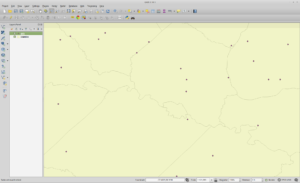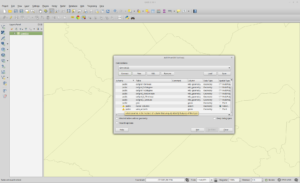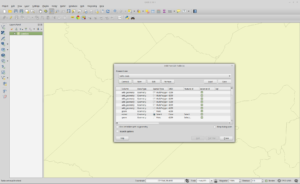Since I’ve been messing around with some data in my spare time, I realized the USGS had put out new GNIS data and I tried to import it into my personal PostGIS database. However, I found out that the NationalFile_20161001.zip file they posted has a LOT of errors where it does not even meet their own data specifications. I’ve uploaded my fixed file here and am copying the issues I reported to them below. Basically, for duplicated keys, I removed the entry that was in Mexico or Canada and kept the US one.
Here’s the list of stuff I reported and fixed in mine:
Hey guys, found a few things with the file at http://geonames.usgs.gov/docs/stategaz/NationalFile_20161001.zip that looks like it doesn’t match up with the file format at: http://geonames.usgs.gov/domestic/download_data.htm
Some of the entries have a three character state alpha code while the format entry says it should be two characters. These are ID 45605, 45606, 45608, and 45610. They have the entry of SON which is the Sonora region in Mexico. The primary coordinates are indeed in Mexico while the source coordinates are all in Arizona.
This also looks to cause some duplicate key problems. There are two lines with feature id 45605 in the file:
45605|Parker Canyon|Valley|AZ|04|||311900N|1103602W|31.3167684|-110.6006372|312750N|1102532W|31.4639862|-110.4256371|1399|4590|Lochiel|02/08/1980|12/10/2010
45605|Parker Canyon|Valley|SON|26|||311900N|1103602W|31.3167684|-110.6006372|312750N|1102532W|31.4639862|-110.4256371|1399|4590|Lochiel|02/08/1980|12/10/2010
45606 also is duplicate entries in the file:
45606|San Antonio Canyon|Valley|AZ|04|||311910N|1103732W|31.3195459|-110.6256374|312211N|1104334W|31.3697222|-110.7261111|1421|4662|Duquesne|02/08/1980|12/10/2010^M
45606|San Antonio Canyon|Valley|SON|26|||311910N|1103732W|31.3195459|-110.6256374|312211N|1104334W|31.3697222|-110.7261111|1421|4662|Duquesne|02/08/1980|12/10/2010^M
and 45608:
45608|Silver Creek|Stream|AZ|04|||311900N|1091632W|31.3167713|-109.2756155|313157N|1092403W|31.5325979|-109.4008983|1135|3724|San Bernardino Ranch|02/08/1980|12/10/2010^M
45608|Silver Creek|Stream|SON|26|||311900N|1091632W|31.3167713|-109.2756155|313157N|1092403W|31.5325979|-109.4008983|1135|3724|San Bernardino Ranch|02/08/1980|12/10/2010^M
and 45610:
45610|Sycamore Canyon|Valley|AZ|04|||311600N|1112302W|31.2667647|-111.3839874|312627N|1110832W|31.4408333|-111.1422222|1006|3300|Unknown|02/08/1980|12/10/2010
45610|Sycamore Canyon|Valley|SON|26|||311600N|1112302W|31.2667647|-111.3839874|312627N|1110832W|31.4408333|-111.1422222|1006|3300|Unknown|02/08/1980|12/10/2010
Also found other duplicate feature id’s that contain the same ID in the US and Canada:
567773|Hovey Hill|Summit|ME|23|||460650N|0674629W|46.11397|-67.77468|||||252|827|Houlton South|08/27/2002|04/29/2011
567773|Hovey Hill|Summit|NB|04|||460650N|0674629W|46.11397|-67.77468|||||252|827|Houlton South|08/27/2002|04/29/2011
581558|Saint John River|Stream|ME|23|||451501N|0660258W|45.2503524|-66.0493904|463347N|0695305W|46.5630872|-69.8847913|0|0|Unknown|09/30/1980|11/22/2010^M
581558|Saint John River|Stream|NB|04|||451501N|0660258W|45.2503524|-66.0493904|463347N|0695305W|46.5630872|-69.8847913|0|0|Unknown|09/30/1980|11/22/2010^M
768593|Bear Gulch|Valley|AB|01|||490900N|1111303W|49.1500183|-111.217465|485224N|1110900W|48.8733364|-111.1499739|881|2890|Hawley Hill|04/04/1980|03/29/2011^M
768593|Bear Gulch|Valley|MT|30|||490900N|1111303W|49.1500183|-111.217465|485224N|1110900W|48.8733364|-111.1499739|881|2890|Hawley Hill|04/04/1980|03/29/2011^M
774267|Miners Coulee|Valley|AB|01|||490600N|1112303W|49.1000165|-111.3841398|484405N|1113008W|48.734721|-111.5022226|906|2972|Johannson Coulee|04/04/1980|03/29/2011^M
774267|Miners Coulee|Valley|MT|30|||490600N|1112303W|49.1000165|-111.3841398|484405N|1113008W|48.734721|-111.5022226|906|2972|Johannson Coulee|04/04/1980|03/29/2011^M
774784|North Fork Milk River|Stream|AB|01|||490814N|1122233W|49.1373|-112.37589|485411N|1131903W|48.90298|-113.31749|1083|3553|Unknown|04/04/1980|12/14/2010^M
774784|North Fork Milk River|Stream|MT|30|||490814N|1122233W|49.1373|-112.37589|485411N|1131903W|48.90298|-113.31749|1083|3553|Unknown|04/04/1980|12/14/2010^M
775339|Police Creek|Stream|AB|01|||490753N|1110005W|49.13141|-111.00148|485818N|1110859W|48.9716762|-111.1496898|862|2828|Unknown|04/04/1980|12/14/2010^M
775339|Police Creek|Stream|MT|30|||490753N|1110005W|49.13141|-111.00148|485818N|1110859W|48.9716762|-111.1496898|862|2828|Unknown|04/04/1980|12/14/2010^M
776125|Saint Mary River|Stream|AB|01|||493738N|1125313W|49.62728|-112.88701|483713N|1134437W|48.6202|-113.74362|835|2739|Unknown|04/04/1980|12/14/2010^M
776125|Saint Mary River|Stream|MT|30|||493738N|1125313W|49.62728|-112.88701|483713N|1134437W|48.6202|-113.74362|835|2739|Unknown|04/04/1980|12/14/2010^M
778142|Waterton River|Stream|AB|01|||493146N|1131616W|49.52941|-113.27119|484947N|1135939W|48.8296967|-113.9942925|960|3150|Unknown|04/04/1980|12/14/2010^M
778142|Waterton River|Stream|MT|30|||493146N|1131616W|49.52941|-113.27119|484947N|1135939W|48.8296967|-113.9942925|960|3150|Unknown|04/04/1980|12/14/2010^M
778545|Willow Creek|Stream|AB|01|||490929N|1131056W|49.15802|-113.18235|485705N|1131913W|48.95133|-113.32035|1147|3763|Unknown|04/04/1980|12/14/2010^M
778545|Willow Creek|Stream|MT|30|||490929N|1131056W|49.15802|-113.18235|485705N|1131913W|48.95133|-113.32035|1147|3763|Unknown|04/04/1980|12/14/2010^M
798995|Lee Creek|Stream|AB|01|||491326N|1131559W|49.22393|-113.26636|485500N|1133812W|48.9166504|-113.6367702|1110|3642|Unknown|04/04/1980|12/14/2010^M
798995|Lee Creek|Stream|MT|30|||491326N|1131559W|49.22393|-113.26636|485500N|1133812W|48.9166504|-113.6367702|1110|3642|Unknown|04/04/1980|12/14/2010^M
790166|Screw Creek|Stream|BC|02|||490026N|1154647W|49.00719|-115.77985|485757N|1154558W|48.96571|-115.7662|1147|3763|Garver Mountain OE N|04/04/1980|12/14/2010^M
790166|Screw Creek|Stream|MT|30|||490026N|1154647W|49.00719|-115.77985|485757N|1154558W|48.96571|-115.7662|1147|3763|Garver Mountain OE N|04/04/1980|12/14/2010^M
793276|Wigwam River|Stream|BC|02|||491437N|1150546W|49.24355|-115.09616|485754N|1145120W|48.96509|-114.8556|800|2625|Unknown|04/04/1980|12/14/2010^M
793276|Wigwam River|Stream|MT|30|||491437N|1150546W|49.24355|-115.09616|485754N|1145120W|48.96509|-114.8556|800|2625|Unknown|04/04/1980|12/14/2010^M
1504446|Depot Creek|Stream|BC|02|||490146N|1212408W|49.02937|-121.40227|485752N|1211553W|48.96439|-121.2646|622|2041|Copper Mountain OE N|01/01/2000|12/10/2010^M
1504446|Depot Creek|Stream|WA|53|||490146N|1212408W|49.02937|-121.40227|485752N|1211553W|48.96439|-121.2646|622|2041|Copper Mountain OE N|01/01/2000|12/10/2010^M
1515954|Arnold Slough|Stream|BC|02|||490141N|1221115W|49.02799|-122.18741|485857N|1221336W|48.98253|-122.22663|11|36|Kendall OE N|01/01/2000|12/10/2010^M
1515954|Arnold Slough|Stream|WA|53|||490141N|1221115W|49.02799|-122.18741|485857N|1221336W|48.98253|-122.22663|11|36|Kendall OE N|01/01/2000|12/10/2010^M
1515973|Ashnola River|Stream|BC|02|||491330N|1195824W|49.22511|-119.97336|485341N|1201451W|48.89467|-120.24751|445|1460|Unknown|01/01/2000|12/10/2010^M
1515973|Ashnola River|Stream|WA|53|||491330N|1195824W|49.22511|-119.97336|485341N|1201451W|48.89467|-120.24751|445|1460|Unknown|01/01/2000|12/10/2010^M
1516047|Baker Creek|Stream|BC|02|||490249N|1190648W|49.04681|-119.1133|485811N|1191213W|48.9696255|-119.203658|812|2664|Chesaw OE N|01/01/2000|12/10/2010^M
1516047|Baker Creek|Stream|WA|53|||490249N|1190648W|49.04681|-119.1133|485811N|1191213W|48.9696255|-119.203658|812|2664|Chesaw OE N|01/01/2000|12/10/2010^M
1517465|Castle Creek|Stream|BC|02|||490321N|1204355W|49.05587|-120.73202|485823N|1205225W|48.97303|-120.87356|1138|3734|Frosty Creek OE N|01/01/2000|12/10/2010^M
1517465|Castle Creek|Stream|WA|53|||490321N|1204355W|49.05587|-120.73202|485823N|1205225W|48.97303|-120.87356|1138|3734|Frosty Creek OE N|01/01/2000|12/10/2010^M
1517496|Cathedral Fork|Stream|BC|02|||490243N|1201754W|49.04524|-120.29836|485913N|1201251W|48.98699|-120.21427|1511|4957|Ashnola Pass OE N|01/01/2000|12/10/2010^M
1517496|Cathedral Fork|Stream|WA|53|||490243N|1201754W|49.04524|-120.29836|485913N|1201251W|48.98699|-120.21427|1511|4957|Ashnola Pass OE N|01/01/2000|12/10/2010^M
1517707|Chilliwack River|Stream|BC|02|||490545N|1215745W|49.09579|-121.96258|485303N|1213142W|48.8842929|-121.5284712|35|115|Glacier OE N|09/10/1979|12/09/2010^M
1517707|Chilliwack River|Stream|WA|53|||490545N|1215745W|49.09579|-121.96258|485303N|1213142W|48.8842929|-121.5284712|35|115|Glacier OE N|09/10/1979|12/09/2010^M
1517762|Chuchuwanteen Creek|Stream|BC|02|||490324N|1204346W|49.05664|-120.72953|485403N|1204433W|48.9008333|-120.7425|1133|3717|Frosty Creek OE N|01/01/2000|12/10/2010^M
1517762|Chuchuwanteen Creek|Stream|WA|53|||490324N|1204346W|49.05664|-120.72953|485403N|1204433W|48.9008333|-120.7425|1133|3717|Frosty Creek OE N|01/01/2000|12/10/2010^M
1519414|Ewart Creek|Stream|BC|02|||490803N|1200213W|49.13426|-120.03686|485943N|1200951W|48.9954|-120.16423|738|2421|Unknown|01/01/2000|12/10/2010^M
1519414|Ewart Creek|Stream|WA|53|||490803N|1200213W|49.13426|-120.03686|485943N|1200951W|48.9954|-120.16423|738|2421|Unknown|01/01/2000|12/10/2010^M
1520446|Haig Creek|Stream|BC|02|||490110N|1200226W|49.01941|-120.0405|485828N|1200319W|48.97443|-120.05531|1485|4872|Unknown|01/01/2000|12/10/2010^M
1520446|Haig Creek|Stream|WA|53|||490110N|1200226W|49.01941|-120.0405|485828N|1200319W|48.97443|-120.05531|1485|4872|Unknown|01/01/2000|12/10/2010^M
1520654|Heather Creek|Stream|BC|02|||490136N|1204246W|49.02678|-120.71267|485834N|1204447W|48.97616|-120.74644|1209|3966|Frosty Creek OE N|01/01/2000|12/10/2010^M
1520654|Heather Creek|Stream|WA|53|||490136N|1204246W|49.02678|-120.71267|485834N|1204447W|48.97616|-120.74644|1209|3966|Frosty Creek OE N|01/01/2000|12/10/2010^M
1521214|International Creek|Stream|BC|02|||490001N|1210524W|49.0004096|-121.0901283|485938N|1210845W|48.9940199|-121.1459632|487|1598|Hozomeen Mountain OE N|01/01/2000|12/09/2010^M
1521214|International Creek|Stream|WA|53|||490001N|1210524W|49.0004096|-121.0901283|485938N|1210845W|48.9940199|-121.1459632|487|1598|Hozomeen Mountain OE N|01/01/2000|12/09/2010^M
1523541|Myers Creek|Stream|BC|02|||490045N|1185120W|49.01263|-118.85546|484726N|1190614W|48.79052|-119.10394|576|1890|Toroda OE N|01/01/2000|12/10/2010^M
1523541|Myers Creek|Stream|WA|53|||490045N|1185120W|49.01263|-118.85546|484726N|1190614W|48.79052|-119.10394|576|1890|Toroda OE N|01/01/2000|12/10/2010^M
1523731|North Creek|Stream|BC|02|||485956N|1182748W|48.99892|-118.4633|485852N|1182601W|48.98117|-118.43373|543|1781|Boundary Mountain|01/01/2000|12/10/2010^M
1523731|North Creek|Stream|WA|53|||485956N|1182748W|48.99892|-118.4633|485852N|1182601W|48.98117|-118.43373|543|1781|Boundary Mountain|01/01/2000|12/10/2010^M
1524131|Pack Creek|Stream|BC|02|||490028N|1181818W|49.00784|-118.30507|485810N|1181743W|48.96957|-118.29533|494|1621|Independent Mountain OE N|01/01/2000|12/10/2010^M
1524131|Pack Creek|Stream|WA|53|||490028N|1181818W|49.00784|-118.30507|485810N|1181743W|48.96957|-118.29533|494|1621|Independent Mountain OE N|01/01/2000|12/10/2010^M
1524235|Pass Creek|Stream|BC|02|||490209N|1205337W|49.0357|-120.89373|485913N|1205146W|48.98682|-120.86274|1238|4062|Skagit Peak OE N|09/10/1979|12/10/2010^M
1524235|Pass Creek|Stream|WA|53|||490209N|1205337W|49.0357|-120.89373|485913N|1205146W|48.98682|-120.86274|1238|4062|Skagit Peak OE N|09/10/1979|12/10/2010^M
1524303|Peeve Creek|Stream|BC|02|||490125N|1203251W|49.02359|-120.54744|485807N|1202303W|48.96853|-120.38415|1156|3793|Tatoosh Buttes OE N|01/01/2000|12/10/2010^M
1524303|Peeve Creek|Stream|WA|53|||490125N|1203251W|49.02359|-120.54744|485807N|1202303W|48.96853|-120.38415|1156|3793|Tatoosh Buttes OE N|01/01/2000|12/10/2010^M
1525297|Russian Creek|Stream|BC|02|||490046N|1172208W|49.01281|-117.369|485847N|1172613W|48.97977|-117.43687|536|1759|Boundary Dam OE N|01/01/2000|12/10/2010^M
1525297|Russian Creek|Stream|WA|53|||490046N|1172208W|49.01281|-117.369|485847N|1172613W|48.97977|-117.43687|536|1759|Boundary Dam OE N|01/01/2000|12/10/2010^M
1525320|Saar Creek|Stream|BC|02|||490246N|1221105W|49.04608|-122.18477|485512N|1221120W|48.92009|-122.1888|7|23|Kendall OE N|01/01/2000|12/10/2010^M
1525320|Saar Creek|Stream|WA|53|||490246N|1221105W|49.04608|-122.18477|485512N|1221120W|48.92009|-122.1888|7|23|Kendall OE N|01/01/2000|12/10/2010^M
1527272|Togo Creek|Stream|BC|02|||490017N|1182431W|49.0046|-118.40865|485844N|1182452W|48.97889|-118.41434|578|1896|Boundary Mountain OE N|01/01/2000|12/10/2010^M
1527272|Togo Creek|Stream|WA|53|||490017N|1182431W|49.0046|-118.40865|485844N|1182452W|48.97889|-118.41434|578|1896|Boundary Mountain OE N|01/01/2000|12/10/2010^M
1529904|McCoy Creek|Stream|BC|02|||490217N|1190745W|49.03804|-119.12922|485945N|1190846W|48.9959|-119.14608|910|2986|Molson OE N|01/01/1992|12/10/2010^M
1529904|McCoy Creek|Stream|WA|53|||490217N|1190745W|49.03804|-119.12922|485945N|1190846W|48.9959|-119.14608|910|2986|Molson OE N|01/01/1992|12/10/2010^M
1529905|Liumchen Creek|Stream|BC|02|||490444N|1215518W|49.07897|-121.92163|485913N|1215555W|48.98695|-121.93198|55|180|Glacier OE N|01/01/1992|12/09/2010^M
1529905|Liumchen Creek|Stream|WA|53|||490444N|1215518W|49.07897|-121.92163|485913N|1215555W|48.98695|-121.93198|55|180|Glacier OE N|01/01/1992|12/09/2010^
942345|Allen Brook|Stream|NY|36|||450501N|0734545W|45.08349|-73.76257|445923N|0734736W|44.98972|-73.79339|58|190|Ellenburg Depot OE N|01/01/2000|12/13/2010^M
942345|Allen Brook|Stream|QC|10|||450501N|0734545W|45.08349|-73.76257|445923N|0734736W|44.98972|-73.79339|58|190|Ellenburg Depot OE N|01/01/2000|12/13/2010^M
949668|English River|Stream|NY|36|||451251N|0734950W|45.21405|-73.83051|445738N|0735325W|44.9605971|-73.8901522|40|131|Unknown|01/23/1980|12/13/2010^M
949668|English River|Stream|QC|10|||451251N|0734950W|45.21405|-73.83051|445738N|0735325W|44.9605971|-73.8901522|40|131|Unknown|01/23/1980|12/13/2010^M
959094|Oak Creek|Stream|NY|36|||450306N|0741123W|45.0517|-74.18964|445803N|0741007W|44.96759|-74.16862|47|154|Unknown|01/01/2000|12/13/2010^M
959094|Oak Creek|Stream|QC|10|||450306N|0741123W|45.0517|-74.18964|445803N|0741007W|44.96759|-74.16862|47|154|Unknown|01/01/2000|12/13/2010^M
967898|Trout River|Stream|NY|36|||450426N|0741104W|45.07379|-74.18458|444757N|0741038W|44.79916|-74.17713|44|144|Unknown|01/23/1980|12/13/2010^M
967898|Trout River|Stream|QC|10|||450426N|0741104W|45.07379|-74.18458|444757N|0741038W|44.79916|-74.17713|44|144|Unknown|01/23/1980|12/13/2010^M
975764|Richelieu River|Stream|QC|10|||460254N|0730712W|46.04828|-73.11991|445848N|0732104W|44.9800394|-73.3512441|6|20|Unknown|05/01/1994|12/10/2010^M
975764|Richelieu River|Stream|VT|50|||460254N|0730712W|46.04828|-73.11991|445848N|0732104W|44.9800394|-73.3512441|6|20|Unknown|05/01/1994|12/10/2010^M
1458184|Leavit Brook|Stream|QC|10|||450224N|0723117W|45.0401|-72.52146|445939N|0723020W|44.99411|-72.50552|152|499|Jay Peak OE N|10/29/1980|12/10/2010^M
1458184|Leavit Brook|Stream|VT|50|||450224N|0723117W|45.0401|-72.52146|445939N|0723020W|44.99411|-72.50552|152|499|Jay Peak OE N|10/29/1980|12/10/2010^M
1458967|Pike River|Stream|QC|10|||450420N|0730546W|45.07219|-73.09608|450126N|0724400W|45.02383|-72.73335|31|102|Highgate Center OE N|01/01/2000|12/10/2010^M
1458967|Pike River|Stream|VT|50|||450420N|0730546W|45.07219|-73.09608|450126N|0724400W|45.02383|-72.73335|31|102|Highgate Center OE N|01/01/2000|12/10/2010^M
1028583|Cypress Creek|Stream|MB|03|||491224N|0990446W|49.2066713|-99.0795409|485328N|0985320W|48.8911174|-98.8890169|408|1339|Unknown|02/13/1980|12/07/2010^M
1028583|Cypress Creek|Stream|ND|38|||491224N|0990446W|49.2066713|-99.0795409|485328N|0985320W|48.8911174|-98.8890169|408|1339|Unknown|02/13/1980|12/07/2010^M
1035871|Mowbray Creek|Stream|MB|03|||490315N|0982829W|49.0541692|-98.4748273|485846N|0982958W|48.9794471|-98.4995594|363|1191|Mount Carmel OE N|01/01/2000|12/10/2010^M
1035871|Mowbray Creek|Stream|ND|38|||490315N|0982829W|49.0541692|-98.4748273|485846N|0982958W|48.9794471|-98.4995594|363|1191|Mount Carmel OE N|01/01/2000|12/10/2010^M
1035887|Gimby Creek|Stream|MB|03|||490530N|0991916W|49.0916735|-99.3212312|485810N|0994454W|48.969583|-99.74822|458|1503|Saint John|01/01/2000|12/10/2010^M
1035887|Gimby Creek|Stream|ND|38|||490530N|0991916W|49.0916735|-99.3212312|485810N|0994454W|48.969583|-99.74822|458|1503|Saint John|01/01/2000|12/10/2010^M
1035890|Red River of the North|Stream|MB|03|||502401N|0964800W|50.4002778|-96.8|461552N|0963555W|46.2644033|-96.5986848|218|715|Unknown|01/01/2000|12/10/2010^M
1035890|Red River of the North|Stream|ND|38|||502401N|0964800W|50.4002778|-96.8|461552N|0963555W|46.2644033|-96.5986848|218|715|Unknown|01/01/2000|12/10/2010^M
1035895|Wakopa Creek|Stream|MB|03|||490110N|0995331W|49.0194503|-99.892073|485806N|0995046W|48.9683394|-99.8462455|605|1985|Carpenter Lake|01/01/2000|12/10/2010^M
1035895|Wakopa Creek|Stream|ND|38|||490110N|0995331W|49.0194503|-99.892073|485806N|0995046W|48.9683394|-99.8462455|605|1985|Carpenter Lake|01/01/2000|12/10/2010^M
1930555|Red River Valley of the North|Valley|MB|03|||502400N|0964800W|50.4|-96.8|485228N|0971042W|48.8744306|-97.1783987|218|715|Unknown|08/06/2001|04/14/2011^M
1930555|Red River Valley of the North|Valley|ND|38|||502400N|0964800W|50.4|-96.8|485228N|0971042W|48.8744306|-97.1783987|218|715|Unknown|08/06/2001|04/14/2011^M
1035882|East Branch Short Creek|Stream|ND|38|||490130N|1025044W|49.0250311|-102.8454552|484543N|1023028W|48.7619785|-102.5076725|552|1811|Unknown|01/01/2000|12/10/2010^M
1035882|East Branch Short Creek|Stream|SK|11|||490130N|1025044W|49.0250311|-102.8454552|484543N|1023028W|48.7619785|-102.5076725|552|1811|Unknown|01/01/2000|12/10/2010^M
1782010|Manitoulin Basin|Basin|MI|26|||450000N|0822000W|45.0000192|-82.3332616|||||176|577|Unknown|02/23/1998|12/09/2010^M
1782010|Manitoulin Basin|Basin|ON|08|||450000N|0822000W|45.0000192|-82.3332616|||||176|577|Unknown|02/23/1998|12/09/2010^M
Just wanted to let someone know since I ran into some problems trying to import them into a db. Thanks!







